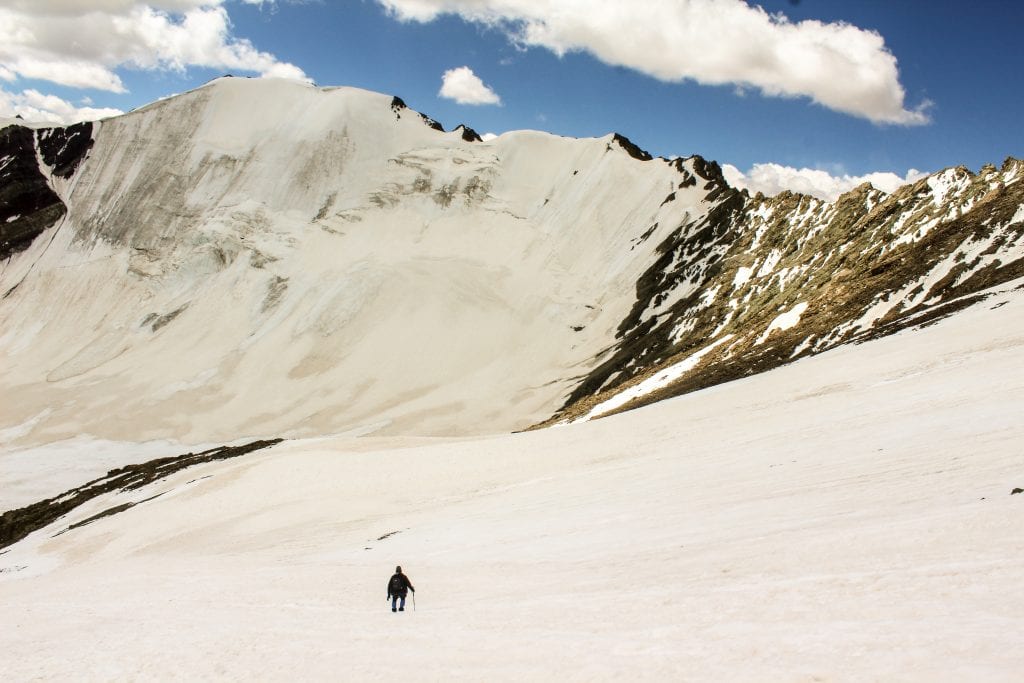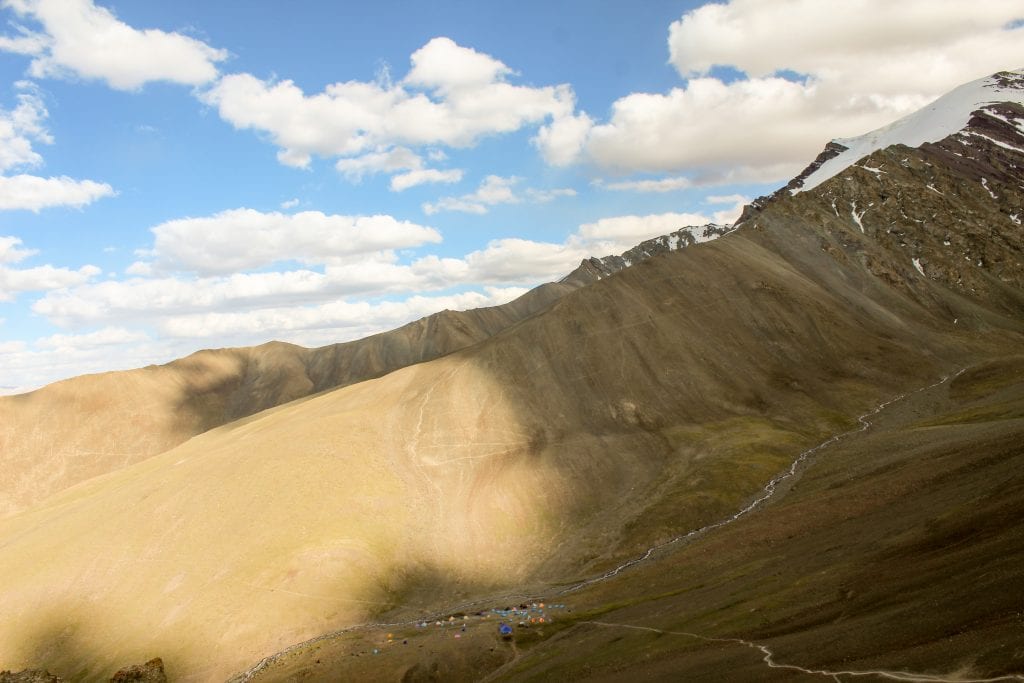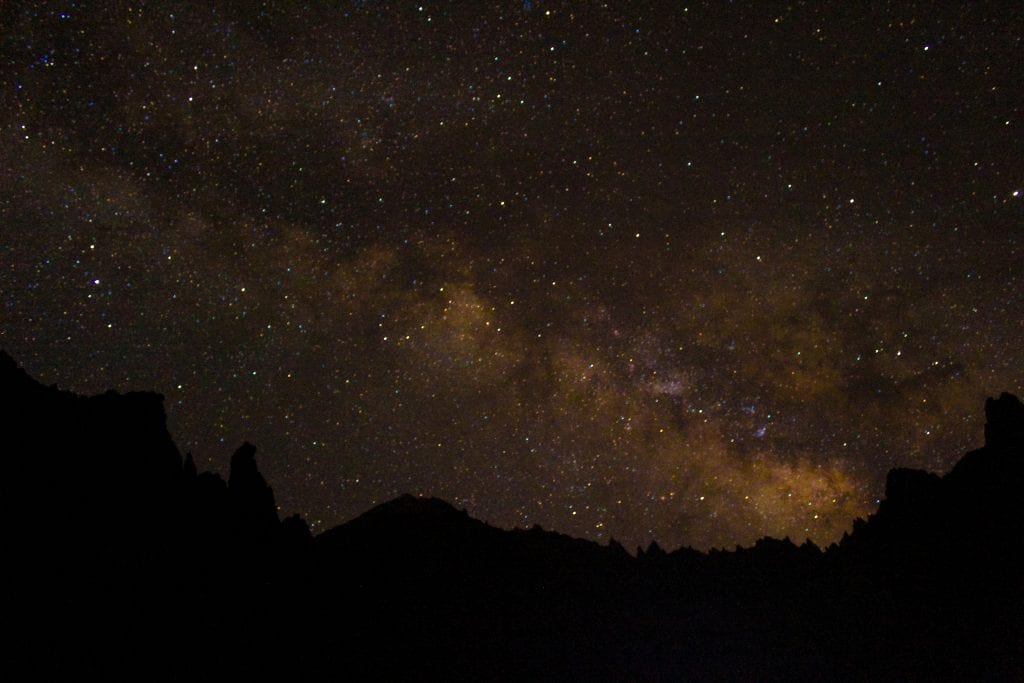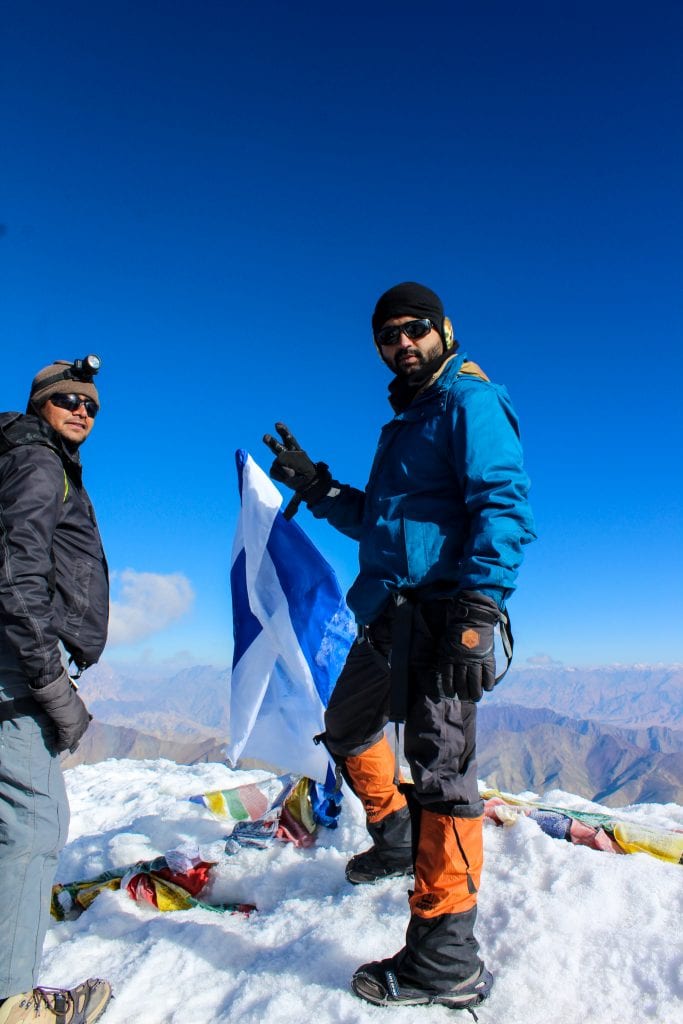I squinted my eyes and saw the farthest peak in Karakoram Range, Pakistan. I tried to shield my eyes from the intense Sun by placing my thumb and finger on my forehead. The cold winds and intense Sun created an unforgiving combination. I was at a height of 20,187 feet, atop Stok Kangri peak. The only sounds I could hear were that of whooshing wind under my skullcap and faint sounds of my trek mates celebrating the successful summit. My body was both cold and warm at the same time. At more than 20,000 feet, the ice cold wind didn’t seem to fall back. But, proximity to the Sun as compared to sea level also made the heat intense.
Laden under the burden of sleep, hunger and exhaustion, my body had never been in such a hostile setup. My mind contemplated escaping to the warmth of tents which fluttered at the base camp. But, my heart was excited by this physical and emotional feat of successfully summiting the Stok Kangri peak. I allowed my heart to rejoice. “We have reached the peak after trekking for 10 hours! We can’t just run back from here that soon” I decided. I took a deep breath and let that feeling of triumph sink in. After 4 months of training for Stok Kangri, I was finally admiring the view from Stok Kangri peak. With the trekking pole resting on my shoes and arms wrapped tightly around knees, I rested my tired eyes on the glimmering glacier below. Bathed in bright sun-rays, the glacier looked like one side of a diamond, sparkling in its full glory! I was unable to fathom how a glacier, this beautiful in day, can be so daunting at night while climbing!
I shifted my focus from the glacier and observed the Sun. Unable to stare at the sun for long, my heavy eyelids surrendered to its might. With my eyes closed, I tuned out the excited cheers in the background and ran a quick flashback across my vision.
The Stok Kangri trek starts from Stok, a rustic village tucked in a patch of green at foothills of Stok Kangri peak. A calm stream of Stok river flowed next to the civilization. I had reached Leh 3 days before the 6 day Stok Kangri trek started from Stok village. Trekkers are advised to arrive in Leh one day before the trek starts in order to get acclimatized to the altitude. Many trekkers fly in from Delhi, gaining an altitude of 11,000 feet in hours. Acclimatization becomes very important for such trekkers. But, we had arrived in Leh 3 days in advance to explore the unparallel beauty of Leh. We explored the monasteries and forts along with Tso Moriri Lake. Unfortunately, a landslide had occurred on the Pangong Lake route. But, Tso Moriri Lake was equally beautiful if not more.
The day after we visited Tso Moriri Lake, we had to start our Stok Kangri trek. Starting from Stok village, before reaching the base camp at 16,300 feet, the trek was not very difficult. That was a bit surprising as Stok Kangri peak is considered to be the toughest non technical summit trek in India. However, the last day would explain why. Before reaching the base camp, we stayed at two different campsites. From Stok to base camp, we gained around 5,500 feet. Staying at both the campsites before base camp was a surreal experience. Being a barren landscape, the night winds blow furiously. We had pitched our tents, in shade of mighty hillocks, shielding us from these unforgiving winds.
After staying at these two camps, we finally reached the base camp. At a height of 16,300 feet, acclimatization is very important. Keeping ears open and walking around leisurely helps a great deal. Later that evening, we had an acclimatization walk scheduled. It is said that for proper acclimatization, you should spend some time at an altitude more than your campsite. You should never sleep at the highest altitude you have attained in a day. This helps the body to acclimatize well and these walks are organized for the same reason. During our acclimatization walk, we reached a spot from where Leh town was visible. A faint view of Leh city laid in front of us, glowing in its full glory! It looked at peace, like an infant sleeping in arms of a mother.
We returned to base camp and were welcomed by strong evening winds. A high tempo symphony was created by the tent covers, flapping furiously in the cold waft of wind. We searched for heavy stones to stop tents from uprooting. The wind currents became stronger with the sky turning darker as if persuading the sun not to set.
The light started fading away around us and we were summoned for dinner. Subsequently, a briefing session was held, informing us that the summit trek would start at 9:30 pm the next day. Rest of the day was marked for resting and acclimatizing to 16,300 feet before attempting peak summit at 20,100 feet.
At night, I tried to snap the Milky Way and accidentally captured a shooting star!
The next day brought a lot of emotions. Despite having slept well, I felt drained of energy today. My oxygen levels were normal the day before and physically, I felt good. But, my mind had started doing tricks on me. It kept popping these questions as if challenging my willpower. Are you struggling for breath? Do you feel nauseated? Do you want to cancel tonight’s summit trek? An endless array of questions started a scathing tornado in my mind. I felt anxious!
It has been proven that hormones responsible for both, excitement and anxiety are the same. But, our mind will interpret them according to your ideology. If you are an optimist, you will feel excited. But a doubtful soul would be anxious! As the day withered away slowly to a dewdrop strewn canvas from dust laden frame from, I hoped to control my emotions and convert my anxiety into excitement. The magnificent views around and cheerful trek mates made it plausible and by dinner time, I was set to challenge myself and experience the ultimate thrill of standing at 20,100 feet! However, not all would successfully accomplish the summit feat.
At 9:30 pm that day, out of 28 trekkers in our batch, 23 people stood in the queue to attempt the peak. Rest were already sent back to Leh due to various reasons, mostly because of Altitude Mountain Sickness. We waited for our trek leader to whistle, indicating the commencement of our summit attempt. We checked our crampons and adjusted our headlamps. We were about to embark upon a 14 KM trek. By the time we reach the summit, precarious terrain, the might of nature, unforgiving cold and nerve-wracking altitude would have left us overwhelmed!
Under a dark sky, with only patches of land visible due to our headlamps, the sound of whistle shrieked through silence. We were now trekking towards Stok Kangri peak, wondering what lay in store for the next 10 hours!
As we progressed in our trek, the winds became stronger. The clear night sky sparkled with gloriously lit stars and we kept walking with our eyes glued to the ground. As we gained substantial altitude with every step, our face was thrashed by the ice cold wind. But, our job was to remain unperturbed by any challenge thrown our way! The aim was to gain 4,000 ft and losing to any of the challenges would only cause a setback for us.
We crossed a couple of small glaciers, which indicated altitude gain. We were seeing more patches of snow now and glacier infused wind was getting colder and colder with every step.
Around midnight, Stok Kangri trek started showing its true colours. I started realizing why Stok Kangri was considered as the toughest non technical peak summit in India. A little past midnight, we discovered a 3 KM stretch of glacier. This glacier had a terrific inclination gradient of 70 degrees and would be the chief villain of Stok Kangri trek. Drenched in the night’s darkness, Stok Kangri peak was not yet in our sight. I saw only two things. A dimly lit stretch of the steep glacier, bathed in our headlamp’s light and distant silhouette of fellow trekkers who hiked ahead of me.
We started climbing the glacier. Every step pushed my mind in oscillations. A major dilemma had captured my mind. Should I continue the trek and overcome the challenges or return to the warm sleeping bags which were still unfolded in my base camp tent. The subzero temperature, sheer altitude, insatiable hunger and strong currents of wind pushed my mind more towards giving up.
As I tried to keep my mind motivated, two of my fellow trek mates returned. After a few more steps, I discovered that 5 more people had already returned! We now were 16 folks out of 23, trudging slowly but firmly towards the peak while withstanding the cold winds and unbelievably steep glacier climb. It was becoming difficult to stay motivated when I knew that there is a way to stop this madness! Go back to the base camp!
I started leaning more and more towards quitting. But, I saw a shred of dim light in the sky. In distant horizon, the light had begun a symphony, as if setting up a stage for the mighty Sun. Very mild shades of light were spreading slowly in the dark sky above us. It was still very dark to switch off our headlamps. But, those subtle light shades gave me hope, a hope to accomplish the mission. A hope which would help me witness sunrise from the highest point ever!
“It’s going to be beautiful” I whispered under my breath. That was enough motivation for me! I glued my eyes to the ground and resumed the trek slowly, gasping for air frequently. Oxygen was acting pricey at this crazy altitude.
I trekked continuously for almost an hour, lifting my crampon ridden shoes. I didn’t look up. “You can’t scare me if I don’t look at you” I addressed Stok Kangri peak.
It was 4 am when I took a break and we were close to the shoulder. From there, we would attempt to summit Stok Kangri peak by climbing the neck. While trekking towards the peak’s shoulder, I glanced over my shoulder and noticed a lovely valley bathing in the mild orange and yellow streaks of sunlight. The sky had turned diamond blue and I had received my reward! What a spectacular view it was! I pushed a bit to reach the shoulder quicker. I just wanted to observe the nature’s miracle. I felt alive again!
It was 5:30 am and we were summoned to complete the final leg of Stok Kangri peak summit. A 200-meter ridge still stood between us and the peak. Owing to the steep drops on either side of the ridge, we were roped up in order to prevent accidents.
We were now 14 trekkers trudging with exhaustion towards the 20,100 feet peak. Every step seemed like a herculean task. Stopping midway was not a good idea as whenever I rested my chin on my trekking pole, a wave of sleep hypnotized my brain! I had to stay alert to avoid losing balance and tumble in the valley below.
The ridge climb took longer than expected and finally, we reached the peak after almost 2 dreadful hours! I had defeated the odds and accomplished a mission. For the last 10 months, Stok Kangri trek had captivated my mind and I had finally achieved my dream! It was a great personal feat for me!
The view from Stok Kangri peak was much better than expected. We could see the Karakoram Range in Pakistan and a wide, wide stretch of Leh Ladakh valley adorned the other side of our view. The sun rays were too strong and we were recommended to start the return trek within 10 minutes.
We reached back to the base camp, taking pride in our feat. My trek mates, who returned from midway, shared their reasons. Well, there is a very thin line between foolhardiness and bravery. You need to ask your heart and listen to your body before deciding which direction you should take your next step.
The next day, we reached back to Leh. I looked back at the massive mountains which dominated the vast landscape. Somewhere in those massive mountains stood Stok Kangri peak, the peak which I would never be able to forget!
I am sure Stok Kangri trek would be one my most amazing experiences throughout life. Trekking to the Stok Kangri peak is more than just some adventure. It’s about taking up a challenge, defeating your inner demons and putting your best foot in front. It’s about staying motivated despite all odds.
It’s about life!









